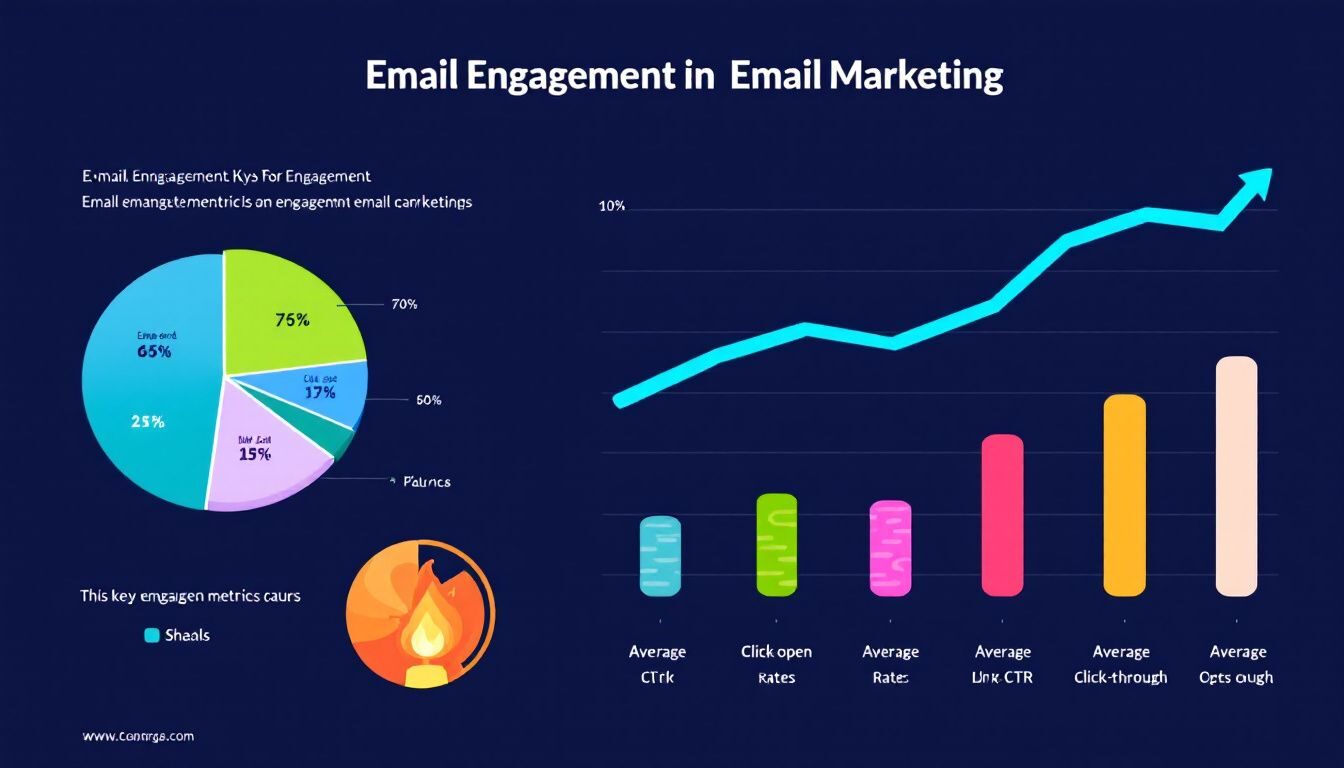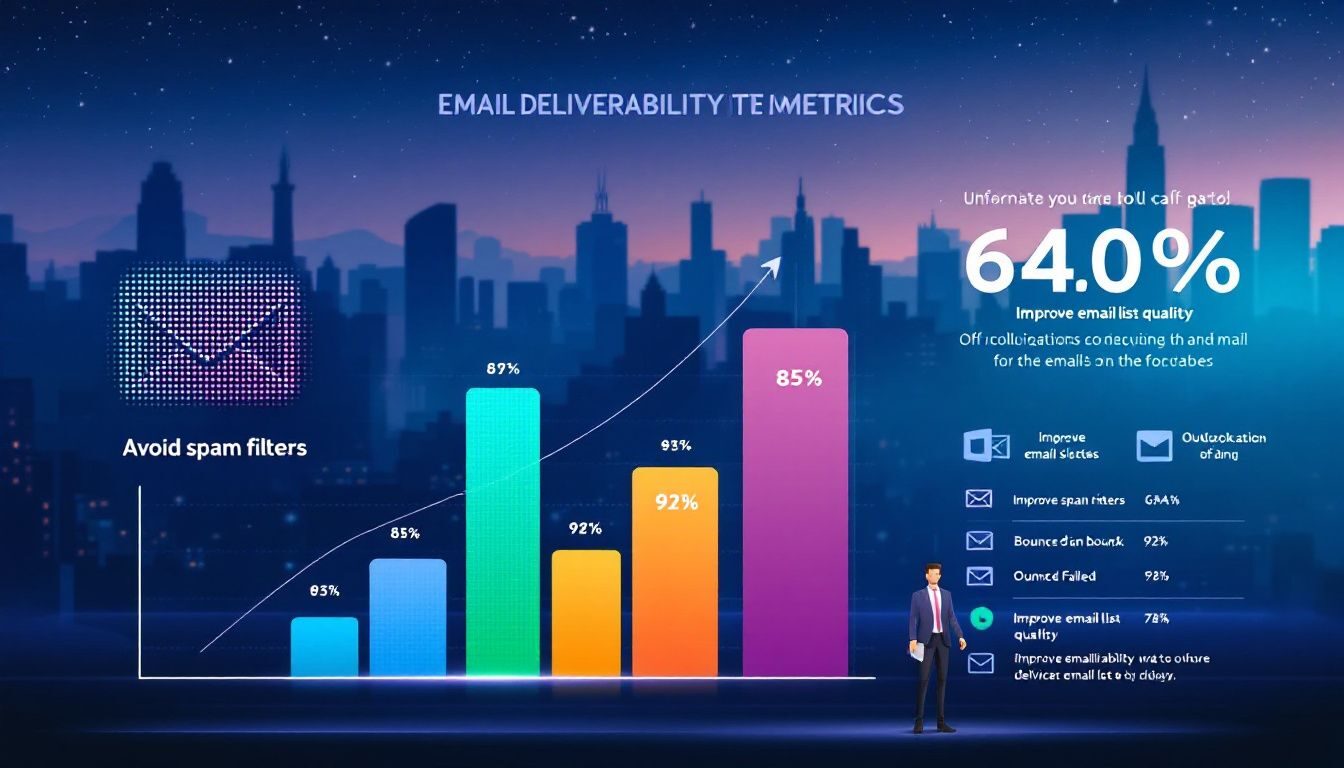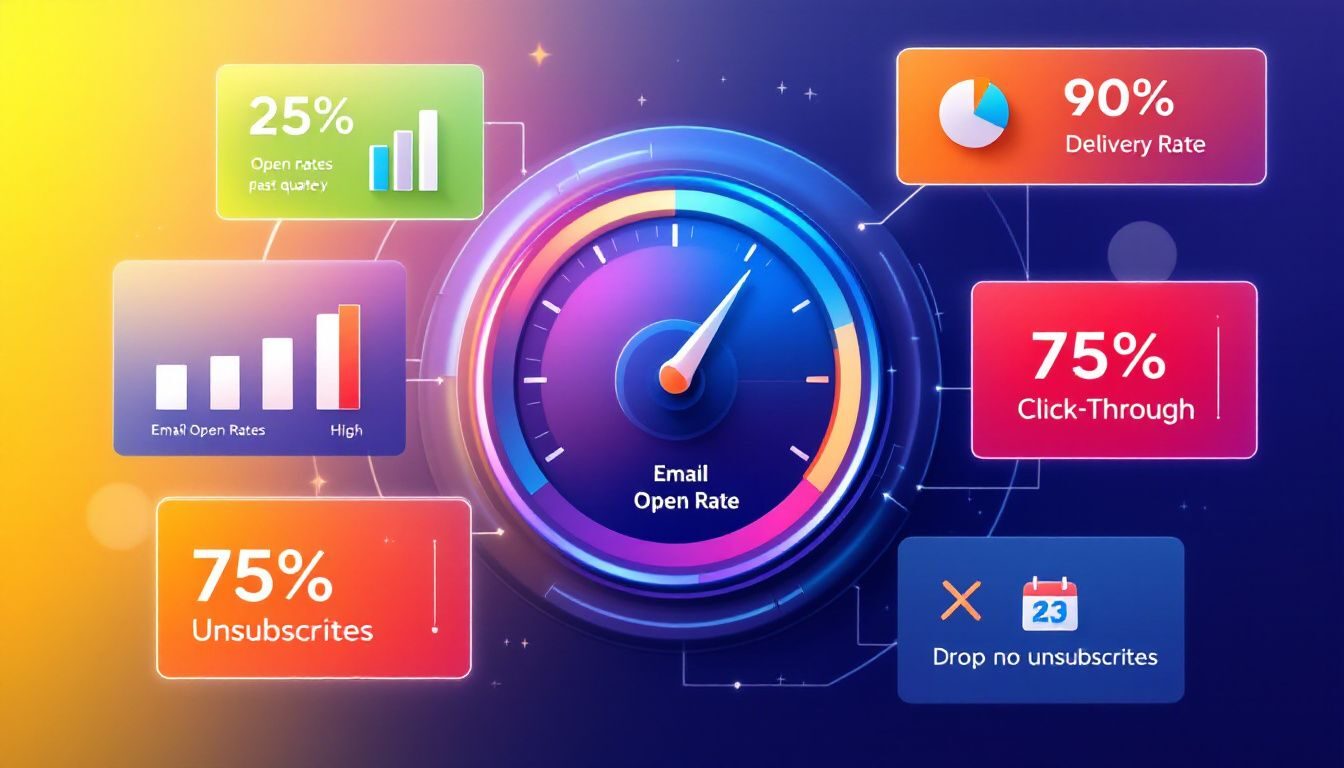https://blog.5gigbucks.com/create-your-very-own-auto-publish-news-blog-site-and-earn-passive-income-in-just-4-easy-steps/
Want to enhance your email campaigns? Learn about the best email marketing metrics to track for optimal results in this article.
Key Takeaways
-
Email marketing metrics are essential for measuring campaign success and identifying improvement areas, with key metrics including open rate, click-through rate, and conversion rate.
-
Engagement metrics like open and click-through rates help tailor email strategies to boost audience interaction and optimize content for better performance.
-
Maintaining list health through metrics such as bounce rate and unsubscribe rate is crucial for sustaining a successful email marketing strategy.
Understanding Email Marketing Metrics
Email performance metrics are the backbone of any successful email marketing strategy. They provide insights into how well your campaigns are performing and highlight areas for improvement. These metrics form the foundation of a strong email marketing strategy and help measure success.
Tracking these metrics enables you to measure your campaign’s effectiveness and achieve your marketing objectives.
What are email marketing metrics?
Email marketing metrics are data points that measure various aspects of your email campaigns, from deliverability to engagement and conversions. These key performance indicators (KPIs) help evaluate campaign performance and identify areas for improvement.
Common metrics include open rate, click-through rate, conversion rate, unsubscribe rate, and bounce rate, all of which provide a comprehensive view of your campaign performance.
Why you should track email marketing metrics
Tracking email marketing metrics is vital for several reasons. Identifying patterns in subscriber behavior helps refine content strategies for improved engagement. Regularly analyzing these metrics boosts your return on investment (ROI), maximizing the impact of your marketing efforts.
Additionally, understanding how often your content is shared on social media can expand your reach beyond your initial audience, attracting new subscribers.
Key Engagement Metrics

Engagement metrics are crucial for understanding how your audience interacts with your emails. These metrics, such as open rates and click-through rates, provide insights into recipient behavior and preferences, helping you tailor your campaigns for maximum impact.
Analyzing these metrics provides insights into content effectiveness, allowing for strategic adjustments.
Open Rate
The open rate is a fundamental email marketing metric that measures the percentage of subscribers who opened your emails. Calculate it by dividing the number of opened emails by the total emails sent and multiplying by 100. Subject lines, personalization, and sending frequency significantly influence your open rates.
Typically, a good open rate for bulk emails ranges between 30-40%, while automated campaigns can achieve even higher rates.
Click-Through Rate (CTR)
Click-through rate (CTR) indicates the percentage of recipients who clicked on links within your email. Calculate CTR by dividing the number of clicks by total emails delivered, then multiplying by 100. CTR is a critical indicator of engagement and the quality of your email content.
To improve CTR, ensure your content is relevant and includes strong calls to action (CTAs). A good CTR to aim for is 4% or higher.
Click-to-Open Rate (CTOR)
Click-to-open rate (CTOR) measures content engagement by comparing clicks to opens. Calculate CTOR by dividing the number of clicks by opens and multiplying by 100. A good benchmark for CTOR is around 10.5%, although aiming for higher is always beneficial.
CTOR indicates whether your email content compels recipients to take action.
Conversion Metrics

Conversion metrics are essential for evaluating the overall performance of your email campaigns. Metrics like conversion rates and revenue per email reveal how effectively your emails generate leads and drive sales.
By focusing on these metrics, you can optimize your campaigns for better financial outcomes.
Conversion Rate
The conversion rate measures the percentage of recipients who complete a desired action after clicking a link in your email. This action could range from making a purchase to signing up for a webinar. Calculate it by dividing the number of completed actions by total emails delivered, then multiplying by 100.
A good conversion rate varies depending on the type of action, but generally, a benchmark of 3-5% for triggered emails is considered good.
Revenue Per Email
Revenue per email sent (RPE) helps assess the financial impact of your email marketing efforts. Calculate RPE by dividing the total revenue generated by the number of emails sent. This provides a clear metric for evaluation. This metric provides a clear picture of the monetary value each email brings to your business.
To increase your RPE, focus on strategies that enhance open rates and overall deliverability.
Return on Investment (ROI)
Return on Investment (ROI) evaluates the profitability of your email campaigns by comparing generated revenue to incurred costs. Calculate ROI by dividing total revenue by total spend and multiplying by 100. A high ROI indicates that your email campaigns are cost-effective and profitable.
On average, email marketing can deliver an ROI of $42 for every $1 spent.
List Health Metrics
List health metrics are crucial for maintaining a robust and engaged email list. Metrics like bounce rates and unsubscribe rates reveal the quality of your email list and highlight areas needing attention.
Monitoring these metrics ensures your email list remains healthy and effective.
Bounce Rate
Bounce rate indicates the percentage of sent emails that were undelivered. Bounces are classified into hard bounces (invalid or non-existent addresses) and soft bounces (temporary issues like full mailboxes).
Regularly monitor and address bounce rates to maintain a healthy email list. Aim to keep your bounce rate below 0.5% for optimal email performance.
Unsubscribe Rate
The unsubscribe rate measures the percentage of recipients who opt-out from receiving future emails. Calculate it by dividing the number of unsubscribes by emails delivered, then multiplying by 100. An unsubscribe rate below 0.5% indicates positive engagement with your email content.
A high unsubscribe rate may signal issues with your content or frequency. To address this, consider including an unsubscribe link in your communications.
List Growth Rate
List growth rate measures the increase in your email list over time. Calculate it by subtracting unsubscribes from new subscribers, dividing by the current number of subscribers, and multiplying by 100.
A positive growth rate is crucial for sustaining a successful email marketing strategy. A good target to aim for is a list growth rate of 2.5%. Strive to achieve this goal.
Deliverability Metrics

Deliverability metrics assess how well your emails reach your recipients’ inboxes without being blocked or marked as spam. Metrics like deliverability rate and spam complaint rate ensure your emails are successfully delivered and read.
Monitoring these metrics helps identify and address potential deliverability issues.
Deliverability Rate
The deliverability rate measures the percentage of emails that were accepted by recipients’ servers. Calculate it by subtracting bounced emails from total emails sent, dividing by total emails sent, and multiplying by 100. A high deliverability rate indicates a clean and healthy email list.
Aim to keep your deliverability rate above 97%.
Spam Complaint Rate
The spam complaint rate measures the percentage of recipients who mark your emails as spam. Calculate it by dividing the number of spam complaints by emails delivered, then multiplying by 100. This will help you monitor your spam complaint rates effectively.
Keeping the spam complaint rate below 0.08% is crucial to maintaining a good sender reputation and ensuring your emails reach the inbox.
Inbox Placement Rate
Inbox placement rate measures the percentage of emails that land in the primary recipient’s inbox rather than the spam or other folders. This metric is essential for understanding how well your emails are being received and read by your audience.
Monitoring this rate helps ensure your emails reach the intended recipients’ inboxes.
Sharing and Forwarding Metrics
Sharing and forwarding metrics are vital for understanding how often recipients share your email content with others. Metrics like email sharing/forwarding rate and social media shares reveal the virality and broader reach of your content.
Tracking these metrics helps optimize content to encourage more shares and forwards.
Email Sharing/Forwarding Rate
The email sharing/forwarding rate measures the percentage of recipients who share or forward your emails. Calculate it by dividing the number of forwards by emails opened, then multiplying by 100. This metric indicates how engaging and shareable your content is, helping you understand its appeal and potential virality.
Social Media Shares
Social media shares significantly increase the visibility of your email content. Social media shares extend your content’s reach, potentially attracting new subscribers.
Tracking these shares helps you understand which content resonates most with your audience and their networks.
Engagement Time Metrics
Engagement time metrics are essential for analyzing how long recipients interact with your email content. By understanding how much time recipients spend viewing your emails, you can optimize your content to capture and retain their attention.
These metrics offer valuable insights into the effectiveness of your email marketing campaign strategies.
Time Spent Viewing Email
The average time a recipient spends viewing an email is a crucial metric for assessing content effectiveness. A significant amount of time spent on your email indicates engaging and relevant content. Short viewing times may suggest that your content needs improvement to maintain reader interest.
Scroll Depth
Scroll depth measures how far recipients scroll in an email, providing insights into which sections capture the most attention. Tracking scroll depth helps identify the most engaging parts of your email, allowing for optimized content placement.
Device and Client Metrics

Device and client metrics are essential for optimizing your email campaigns across different platforms. Understanding device and email client usage helps tailor content for a seamless experience.
This optimization can greatly enhance email service provider effectiveness.
Mobile Open Rate
Mobile open rate indicates the percentage of recipients opening emails on mobile devices. This metric reveals the effectiveness of your emails on mobile platforms.
Optimize for mobile users by ensuring your content is responsive and easily readable on smaller screens.
Email Client Share
Email client share indicates the distribution of email client usage among recipients. Analyzing this metric helps determine which email clients to optimize based on audience breakdown. This information directs development, QA efforts, and troubleshooting deliverability issues.
Subscriber Behavior Metrics
Subscriber behavior metrics reveal how recipients interact with your emails, providing insights into engagement levels and preferences. Tracking these metrics helps tailor email strategies to better meet audience needs.
Active vs. Inactive Subscribers
Active subscribers regularly engage with your emails, while inactive subscribers do not. Automated re-engagement campaigns or removing inactive contacts help maintain a healthy subscriber list.
Incentives or information about missed content can encourage inactive subscribers to re-engage.
Frequency of Opens
Frequency of opens indicates how often recipients open your emails. This metric helps determine the effectiveness of your subject lines and the best timing for sending emails. Understanding this frequency aids in tailoring strategies for different segments and boosting overall engagement.
Summary
Email marketing metrics are powerful tools that provide deep insights into the performance and effectiveness of your email campaigns. By understanding and leveraging these metrics, you can refine your strategies, enhance engagement, and drive better results. From open rates and click-through rates to conversion metrics and list health metrics, each metric plays a critical role in optimizing your email marketing efforts. Keep tracking, analyzing, and adapting your strategies based on these key metrics to ensure continued success in your email marketing endeavors.
Frequently Asked Questions
What are email marketing metrics
Email marketing metrics help you understand how well your campaigns are performing by tracking key data points like open rates, click-through rates, and conversion rates. Keeping an eye on these metrics is essential for improving your strategy and achieving better results.
Why is it important to track email marketing metrics
It’s crucial to track email marketing metrics because it helps you understand subscriber behavior, optimize your content, and boost your return on investment. This way, you can effectively grow your audience and enhance your marketing efforts.
What is a good open rate for email marketing?
A good open rate for email marketing is generally between 30-40% for bulk emails, whereas automated campaigns can see an impressive 40-70%. Aim for these benchmarks to gauge your campaign’s effectiveness!
How do you calculate the click-through rate (CTR)
To calculate the click-through rate (CTR), just divide the number of clicks by the total emails delivered and multiply the result by 100. So if you want to gauge your email performance, this is a quick and effective way to do it!
What is the importance of the spam complaint rate
The spam complaint rate is essential because it reflects how recipients perceive your emails; a low rate boosts your sender reputation and ensures your messages reach the inbox. Keep it in check to stay connected with your audience!
Are you interested in finding out more? Browse the rest of our blog for other marketing tips. If you’re ready to create your first email, survey, sign-up form, or landing page then register for a free trial to get the tools you need to build powerful marketing campaigns!
© 2024, Vertical Response. All rights reserved.
https://blog.5gigbucks.com/create-your-very-own-auto-publish-news-blog-site-and-earn-passive-income-in-just-4-easy-steps/







